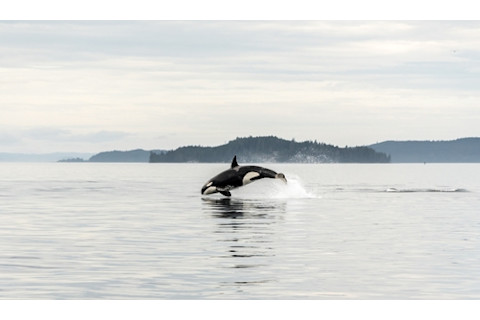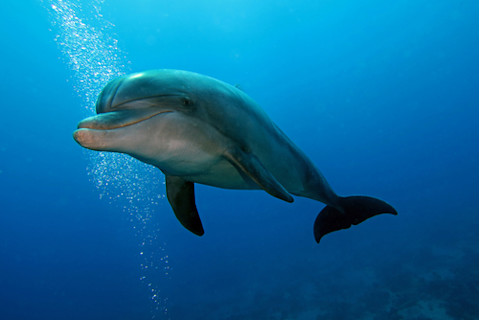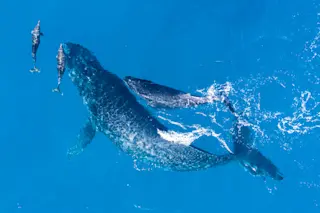The scene was like something out of a children's book. A pod of sperm whales curiously circled around two scientists as they trod water in the Atlantic Ocean near the Azores. The pod included a matriarch who stretched 30 feet long, another adult and two calves. To the scientists' surprise, an adult bottlenose dolphin was also part of the family.
The dolphin had a curved spine, and the scientists thought it was likely a congenital disability that made it hard for the dolphin to keep up with its quick-moving kin. The sperm whales seemed more at the dolphin's pace, and the pod accepted it as a member. This amazed the scientists, who noted that sperm whales and dolphins typically don't associate.
Animals that share space sometimes develop unique relationships. Marine biologists have long wondered about the mammals that swim in the same waters. Dolphins and whales often cross paths. And while they might ignore each other, scientists are also learning how cetaceans sometimes interact and work together. It's a complex relationship because marine mammals can see each other as predators, playmates or prey.
Cetacean Behavior
Marine biologists would like to know more about cetacean behavior but are limited to what they can observe from boats or shallow depths. While what happens deep under the water line is a mystery, scientists have observed insightful encounters at the water's surface.
From the surface, scientists have seen playful encounters between dolphins and whales. In a 2010 article in Aquatic Mammals, researchers described two instances near Hawai'i where humpback whales appeared to be lifting bottlenose dolphins out of the water.
In one instance, a mother was with her calf, and she lifted the dolphin up six times. In the other, a pod of dolphins met up with two whales. Two of the dolphins were lifted several times by the whales.
The dolphins appeared healthy and could easily swim away if needed. They were also passive when lifted, and they didn't flail or fight. The scientists concluded the dolphins and whales were playing with each other.
The authors also noted that dolphins and whales often interact in Hawaiian waters. Bottlenose dolphins mingle with other dolphin species as well as whales. With whales, they typically follow behind humpbacks and surf on the waves they leave in their wake. Scientists think wave riding allows dolphins to travel at a faster pace while spending less energy. They also suspect the dolphins might follow along simply because they enjoy riding the waves.
Cetaceans: Friends or Foes?
In some waters, dolphins don't encounter many whales, so there aren't instances of dolphins playing with them or riding their wakes. The inner Baltic Sea, for example, has "brackish water" that is stressful for many types of marine life. The only type of cetacean there is a harbor porpoise, a marine mammal that resembles a dolphin but has a distinct classification.
Humpback Whales and Dolphins
Humpback whales and dolphins have been known to wander into the inner Baltic Sea, but they are not locals. Thus, whales and dolphins don't have much meaning to these porpoises as they haven't learned over time to see these strangers as friends or foes.
Read More: A New Whale Species Is Fighting for Survival
Other waters also limit the interactions between cetaceans due to depth. The English Channel, for example, is relatively shallow, and some parts are only 50 meters deep. Smaller whales like the minke whale and long-finned pilot whale show up along with the bottlenose dolphin and Risso's dolphin. But the channel isn't home to larger whales like the sperm whale that like to take deep dives under the surface.

(Credit:Daniel Toh/Shutterstock)
Killer Whales and Dolphins
Elsewhere in the ocean, however, cetaceans cross paths on a regular basis and see each other as predators or prey. Although killer whales span the globe, they are most associated with arctic waters, where they hunt other dolphins by herding and cornering them (killer whales are technically dolphins). Killer whales also work together to hunt sperm whales, often in a "wound and withdraw" method that exhausts the much larger sperm whale and makes them easier to kill.
In other waters, sperm whales dine on sharks when given the chance but get bullied by much smaller sea creatures. Several species of dolphins have been seen harassing sperm whales off the coast of California. Increasingly, scientists are finding evidence that different dolphin species will work together in a variety of circumstances.
Read More: Orca Killer Whale Moms Pay a Steep Price to Feed Their Adult Sons
Whales and Dolphins Hunting Together
In a 2022 study in the journal bioRxiv, a team of researchers went on a series of whale-watching tours in July, August and October 2020 near Pico Island in the Azores.
They saw 10 species, most commonly sperm whales, sei whales, Atlantic spotted dolphins, common bottlenose dolphins and Risso's dolphins. They saw many instances in which different dolphin species worked together to hunt. For example, the false killer whale (which is actually a species of dolphin) worked with the common bottlenose dolphin to catch yellowfin tuna as well as various sea birds.
Common bottlenose dolphins also teamed up with Atlantic spotted dolphins to take down some tuna. The study's authors noted that these hunts weren't just quick let-me-block-that-tuna-for-you type of maneuvers. These were ongoing events that spanned nearly five miles (eight kilometers) and involved multiple members of both species' pods.
Dolphin Interaction
In addition to helping each other hunt, the study's authors observed behavior they initially thought was aggressive. In several instances, they saw about 10 bottlenose dolphins interacting with 10 Risso's dolphins. The two groups chased each other, splashed and did short dives only to surface quickly. Several dolphins from the same pod also teamed up to hold a rival dolphin under the water as if they were trying to drown their foe.

(Credit:gilkop/Shutterstock)
The researchers weren't initially sure what they saw. Risso's and bottlenose dolphins have distinct diets, so the scientists didn't think it was a food dispute. They noticed the interactions tended to be between younger males while older ones observed. This opened the possibility that the two species were play fighting to learn how to work together to defend their territory or ward off a predator.
Researchers might debate what these behaviors mean, but they do agree that cetaceans are smart and social animals. There is a lot science still has to learn about their culture, language and behavior.
Read More: Just How Intelligent Are Dolphins?















